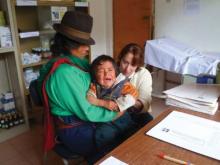Vaccinations were available but were infrequently administered. The infection rates would have likely decreased dramatically with improved use of these vaccines as well as continued education regarding personal hygiene. We saw many cases of both influenza and pneumococcal disease.
Because we were working at about 10,500 feet about sea level, many of our patients had secondary polycythemia. At altitudes that high, your body naturally makes more red blood cells, and we frequently saw hemoglobin levels as high as 18 or 19 in hospitalized, acutely ill patients.
Diabetes (mostly type 2 diabetes) is a big problem in Ecuador as well. It is also one of the leading causes of preventable blindness globally. Unfortunately, for both cultural and financial reasons, the diet of many of the people consists almost entirely of carbohydrates. There is fruit available in the market, but few people from the villages buy it because it is too expensive. Bread, noodles, and potatoes are very cheap and taste good, so often that is all they eat, and this predisposes them to diabetes. Interestingly, because of the altitude and resultant polycythemia, the physicians in Riobamba cannot use the hemoglobin A1c test to screen for diabetes; they use fasting blood sugar instead.
Also, alcohol abuse is a significant problem. There were frequent cultural and religious celebrations in these communities, and we often saw people passed out in the street. Alcoholic liver disease may continue to be a problem even if people are able to quit drinking. We saw many people who were end-stage cirrhotic and needed a liver transplant. But the only hospital in the country that performs liver transplants is several hours away by bus. Patients who need a transplant generally move closer to the hospital and wait until a liver becomes available.
What were the challenges to providing health care in this setting?
A major problem is that the pharmacies are not necessarily run by pharmacists. We were told that anyone can open a pharmacy as long as they have a credentialed pharmacist cosign their papers. After that, the pharmacist need not even set foot in the building, and the pharmacy could be run by just about anybody. These pharmacies dispensed medications at will. On several occasions, we saw pharmacy employees using flashlights to examine customers’ throats and then administering antibiotics or vitamin C tablets depending on what they saw. We walked into a pharmacy in the middle of Riobamba, without a prescription, asked for amoxicillin for a sore throat, and received it easily. As you may imagine, this is a huge public health dilemma.
Patients also do not receive directions about safe dosing. When a patient requests a medication for pain, they routinely are "prescribed" NSAIDs. Basically, they walk out of the pharmacy with a giant bottle of naproxen. Since the patients are seeking pain relief and have not been educated about the risks of NSAIDs, they keep popping the pills like candy. In one month, we saw four cases of NSAID-induced end-stage renal disease that required dialysis. One of the patients was 34-years-old.
The Ecuadorian physicians recognize that this is a big problem, and they have been trying to combat it for decades. These pharmacies are arguably the largest and most dangerous health problem that this population currently faces.
What were the most rewarding aspects of your experience?
It was most rewarding to work with the indigenous community. They were very appreciative of everything we did for them and, despite centuries of relying on traditional or herbal medicines, they were still receptive to foreign doctors, and they allowed us to play a small role in their care.
Also, it was a wonderful experience to work with the public health teams caring for people in their homes and in the Cacha-based clinics. These health care providers crossed an enormous cultural divide themselves as they sought out people in the indigenous communities, many of whom were suspicious of them and occasionally unreceptive to the services being offered. But the Ecuadorian team was always trying to build trust and to let people in the villages know that access to health care existed. We were very inspired by the people who worked tirelessly to meet the health care needs in these communities, day in and day out.
Think globally. Practice locally.

